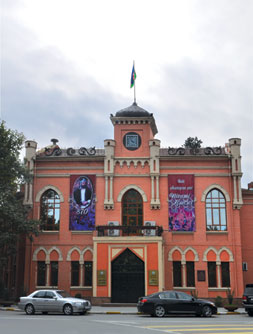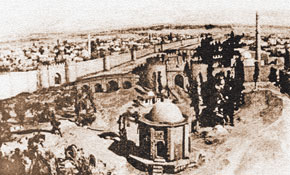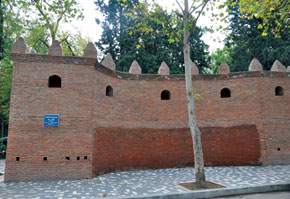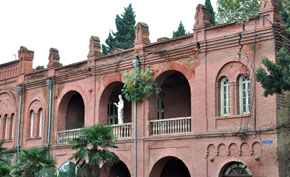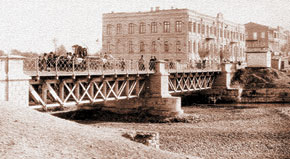Pages 48-52
by Fakhraddin Mammadov
Ganja, located at the north-eastern foot of the Lesser Caucasus Mountains, in one of the most beautiful corners of Azerbaijan, has been significant to the political-economic and cultural life of the country since the earliest of times. Medieval Ganja was known as an important centre of craft and trade throughout the Near and Middle East.
In the 7th century AD the whole area now covered by Azerbaijan, including Ganja, was a battlefield between Arabs and Khazars. Sources say that the Caliphate occupied Ganja and Shirvan and sent Abdul Aziz with a great army against the Khazars. From the second half of the 11th century, Ganja and other cities were exposed to attacks by the Seljuk sultans. They put up strong resistance to Toghrul bey, Alp Arslan and Malikshah.
The city was the home of the great writer Nizami Ganjavi (1141-1209) and reached a peak in its development during the supremacy of the Atabey State (1136-1225). Ibn-al-Asr called it the Mother of Arran and Rashidaddin referred to it as the biggest city in Arran.
After fighting courageous battles against foreign occupiers, Ganja had to contend with natural disaster, an earthquake in 1139, which killed about 250,000 people in all. Still, some 80 years later, in 1221, the freedom-loving Ganja citizens fought determinedly against the Mongols and refused to surrender. The invaders were only able to seize the city in their second campaign (1235); they razed to the ground.
Ganja also had a significant role to play in the history of statehood in Azerbaijan. The Safavid Shah Tahmasib I (1524-1576), established a new administrative division, the beylarbeylik. Ganja was the centre of one of the divisions, the Karabakh beylarbeylik. After the collapse of Nadir Shah’s empire (1747), it was the centre of the Azerbaijani khanate of the same name.
Russian pillage
The ruling Ganja Ziyadoglu khans were from the Gajars dynasty, originating in a Turkic tribe. Under Javad Khan They put up a heroic resistance to the occupying Tsarist Russian forces in Ganja on 3 January 1804. There was correspondence between the bloodthirsty Russian General P.D. Tsitsianov and Javad Khan until that day, with the latter being called to surrender. Javad Khan answered the General’s last letter with:
You will get Ganja only by stepping over my dead body.
And so it happened. The Russians only entered the city after heavy fighting in which Javad Khan was killed. The city was pillaged and General Tsitsianov and his soldiers treated the population of Ganja as captives. In his report to Tsar Alexander I the general wrote:
I captured 8,585 men and 8,639 women in Ganja (region – ed.)
These words were the first indications of Tsarist Russia’s colonial policy towards Azerbaijan. After the occupation of Ganja, Tsitsianov ordered its name to be changed; it was called Yelizavetpol, in honour Alexander I’s wife, Yelizaveta (Elizabeth). Those who used the city’s old name were to be fined the sum of 1 silver manat. Tsitsianov also ordered the dissolution of the Ganja khanate, and its lands were annexed to Russia under the name Yelizavetpol okrug (district).
An 1804 population count in the city, following the occupation, registered 7,303 people. In 1917, the city’s population was 57,731. Ganja became the centre of the district and, later, of the province of the same name.
Resistance reorganised
The city was one of the centres of the struggle against socio-political oppression and colonial servitude from the beginning of the 20th century. Sharp resistance to Armenian massacres of Azerbaijanis was first offered in Ganja and there were significant steps towards political organisation. The political parties Qeyrat (Honour), Difai (Defence – in Farsi – ed.) and Mudafia (Defence) and others were established. Some prominent political figures, such as Khalil Khasmammadov, Khudadat.Rafibeyli, Hasan Agayev and NasibYusifbeyli emerged from Ganja in this period.
After the February 1917 revolution in Russia and the fall of the Tsar, an executive committee of the Ganja Province was established and Khasmammadov was elected head of the city (mayor). In March 1917 under the direction of Nasib bey Yusifbeyli the Turk Edemi-merkeziyyet Partiyasi (Turkic Centre Party) was founded. This party struggled for autonomy for Azerbaijan within a Russia federal state. There was even a rally in the square before the Shah Abbas mosque with slogans like
Long live Democratic Azerbaijan! Long live Azerbaijan autonomy!
The idea of autonomy was also proposed at the convention of Caucasus Muslims which took place in April in Baku. As well as the Executive Committee, the Soviet of Deputies of Workers and Soldiers was also active. The Bolsheviks were trying to bolster their position and their numbers were boosted by Armenian applicants. A united Ganja committee of the Social and Democratic Russian Party of Bolshevik and Menshevik Workers was organised on 10 April. Support for national liberation intensified in the city after the October 1917 revolution. The city played a historical role in declaring Azerbaijan’s independence and its liberation from Bolshevik and Armenian Dashnak forces. On 5 May 1918, Nuru Pasha arrived in Ganja and began to establish his headquarters here.
Independence declared
On 25 May 1918 the Transcaucasian Seim (assembly) was disbanded. Given Azerbaijan’s extremely difficult position and the threat of destruction, a National Council was established in Tbilisi; it was led by M.A.Rasul-zadeh. The National Council of Azerbaijan proclaimed the Declaration of Independence on 8 May 1918. After approval of the declaration, Fatali Khan Khoysky, one of the leading figures in the national liberation movement, was charged with organising the first independent government of the Azerbaijan nation and the first republican government, not only among Turkic-speaking nations but in the whole Islamic world. An hour later Khoysky submitted a Provisional government to the National Council.
The first Cabinet of Ministers of the Azerbaijan Democratic Republic:
1. Chairman of the National Council and Minister of the Interior – Fatali Khoysky
2. Military Minister – Khosrov Sultanov
3. Minister of Foreign Affairs – Mammad Hasan Hajinsky
4. Minister of Finance and Public Education – Nasib Yusifbeyli
5. Minister of Justice – Khalil Khasmammadov
6. Minister of Trade and Industry – Mammad Yusif Jafarov
7. Minister of Agriculture and Property – Akbar Sheykhulislamov
8. Minister of Roads, Post and Telegraph – Khudadat Melikaslanov
9. State Inspector – Jamo Hajinsky
With the Declaration of Independence a new state appeared on the political map of the world. Thus Northern Azerbaijan, whose states – the khanates – had been subsumed 90 years earlier, revived with its first united, centralised and independent national state under a single flag. On 30 June the establishment the Azerbaijan Democratic Republic was telegrammed to the world’s capitals:
For the attention of the Minister of Foreign Affairs, in connection with Georgia leaving the Transcaucasian Federative Republic and its dissolution the Azerbaijan National Council declared the independence of Azerbaijan consisting of Eastern and Southern Transcaucasia and established the Azerbaijan Democratic Republic on 28 May 1918. I would like to bring this event to your notice and ask your Excellency to inform your government. My government is temporarily located in the city of Yelizavetpol (Ganja. – F.M.). Signed by: Khoysky – Chairman of the Council of Ministers of the Republic of Azerbaijan.
Governing from Ganja…
After 18 days of work in Tbilisi the National Council and the government of the ADR moved to Ganja, regarded as a cradle of the struggle for independence and declared the capital of the ADR. Progress there was by no means quiet or serene. Clerics, the bourgeoisie and landowners flocked there from every corner of the country; the most reactionary were upset at the prospect of a National Council and government by people with democratic and even revolutionary tendencies. There was a campaign to annexe Azerbaijan to Ottoman Turkey; however, most of the freedom fighters led by M.A.Rasul-zadeh opposed such a move. The National Council then agreed at its 7th meeting, on 17 June, to suspend its work on condition that all authority would be transferred to the Khoysky-led government and that the government would not cede authority to anyone other than the Parliament to be elected soon afterwards. Khoysky organised his second Cabinet on the same day.
… and building a state…
While in Ganja the ADR government adopted more than 120 decisions on state building and city life, including the adoption of state symbols. On 21 June 1918 a resolution on the national flag was accepted. At first it was to be red with a white crescent and eight-pointed star. On 9 November 1918 this was replaced by the three-colour (blue, green and red) flag.
Public administration was established for Ganja city on 22 June, with 150,000 manats in interest-free credit allocated to assist its performance. On 27 June the militia (police) was transferred to local government control and on 30 July the historical name of Ganja was restored to the city. Meanwhile, Turkic (ie. Azerbaijani – ed.) was declared to be the state language and a national anthem was adopted, with words by Ahmad Javad to Uzeyir Hajibeyov’s music.
…for the whole of Azerbaijan
On 23 June, the government proclaimed a state of martial law over all Azerbaijan. The newly formed Army of Islam, based on the 5th Ottoman foot division and a national corps of some 600 volunteers headed by General Aliaga Shikhlinsky, were given the tasks of liberating Baku by the middle of September 1918 and establishing governmental authority in the regions. Forces sent by the Baku Soviet of People’s Commissars to remove the ADR government were repulsed after tense battles. The Army of Islam, commanded by Nuru Pasha, counterattacked near Goychay and moved towards Baku. The army’s victory in Goychay was a turning point in the war to liberate the eastern part of Azerbaijan, including Baku, from Bolshevik and Dashnak occupation. The Baku Commune and Soviet military units were heavily defeated at Binagadi and forced to retreat along the whole front.
The Caucasus Army of Islam completed its triumphal march with the liberation of Baku on 15 September. On 17 September the government of the Azerbaijan Democratic Republic moved to Baku.
Although Baku was now the capital city, Ganja still continued to play an important role in the life of the country. Even after Turkish forces left Azerbaijan under the Treaty of Moudros (October 1918), the process of forming a national army was continued there. Thus, the Azerbaijan Democratic Republic began life in freedom-loving Ganja, its first capital city, and moved on from there to liberate the east of the country and establish its sway over the whole country.
Literature
Azerbaijan history. 7 volumes, volume 5. Baku, 2008
Azerbaijan history, 19th century and the beginning of the 20th century. Baku, 2010
Encyclopaedia of the Azerbaijan Democratic Republic, 2 volumes, volume 1. Baku, 2004
F. Mammadov Cradle of the Struggle for Independence. Baku, 2003
The Azerbaijan Democratic Republic (1918-1920) (in Russian). Baku, 1998
About the author: Professor Fakhraddin Mammadov is a PhD in history. He is head of the Azerbaijan History Department in the Medical University. He has researched the history of Ganja city and is the author of monographs and articles on the subject.
by Fakhraddin Mammadov
Ganja, located at the north-eastern foot of the Lesser Caucasus Mountains, in one of the most beautiful corners of Azerbaijan, has been significant to the political-economic and cultural life of the country since the earliest of times. Medieval Ganja was known as an important centre of craft and trade throughout the Near and Middle East.
In the 7th century AD the whole area now covered by Azerbaijan, including Ganja, was a battlefield between Arabs and Khazars. Sources say that the Caliphate occupied Ganja and Shirvan and sent Abdul Aziz with a great army against the Khazars. From the second half of the 11th century, Ganja and other cities were exposed to attacks by the Seljuk sultans. They put up strong resistance to Toghrul bey, Alp Arslan and Malikshah.
The city was the home of the great writer Nizami Ganjavi (1141-1209) and reached a peak in its development during the supremacy of the Atabey State (1136-1225). Ibn-al-Asr called it the Mother of Arran and Rashidaddin referred to it as the biggest city in Arran.
After fighting courageous battles against foreign occupiers, Ganja had to contend with natural disaster, an earthquake in 1139, which killed about 250,000 people in all. Still, some 80 years later, in 1221, the freedom-loving Ganja citizens fought determinedly against the Mongols and refused to surrender. The invaders were only able to seize the city in their second campaign (1235); they razed to the ground.
Ganja also had a significant role to play in the history of statehood in Azerbaijan. The Safavid Shah Tahmasib I (1524-1576), established a new administrative division, the beylarbeylik. Ganja was the centre of one of the divisions, the Karabakh beylarbeylik. After the collapse of Nadir Shah’s empire (1747), it was the centre of the Azerbaijani khanate of the same name.
Russian pillage
The ruling Ganja Ziyadoglu khans were from the Gajars dynasty, originating in a Turkic tribe. Under Javad Khan They put up a heroic resistance to the occupying Tsarist Russian forces in Ganja on 3 January 1804. There was correspondence between the bloodthirsty Russian General P.D. Tsitsianov and Javad Khan until that day, with the latter being called to surrender. Javad Khan answered the General’s last letter with:
You will get Ganja only by stepping over my dead body.
And so it happened. The Russians only entered the city after heavy fighting in which Javad Khan was killed. The city was pillaged and General Tsitsianov and his soldiers treated the population of Ganja as captives. In his report to Tsar Alexander I the general wrote:
I captured 8,585 men and 8,639 women in Ganja (region – ed.)
These words were the first indications of Tsarist Russia’s colonial policy towards Azerbaijan. After the occupation of Ganja, Tsitsianov ordered its name to be changed; it was called Yelizavetpol, in honour Alexander I’s wife, Yelizaveta (Elizabeth). Those who used the city’s old name were to be fined the sum of 1 silver manat. Tsitsianov also ordered the dissolution of the Ganja khanate, and its lands were annexed to Russia under the name Yelizavetpol okrug (district).
An 1804 population count in the city, following the occupation, registered 7,303 people. In 1917, the city’s population was 57,731. Ganja became the centre of the district and, later, of the province of the same name.
Resistance reorganised
The city was one of the centres of the struggle against socio-political oppression and colonial servitude from the beginning of the 20th century. Sharp resistance to Armenian massacres of Azerbaijanis was first offered in Ganja and there were significant steps towards political organisation. The political parties Qeyrat (Honour), Difai (Defence – in Farsi – ed.) and Mudafia (Defence) and others were established. Some prominent political figures, such as Khalil Khasmammadov, Khudadat.Rafibeyli, Hasan Agayev and NasibYusifbeyli emerged from Ganja in this period.
After the February 1917 revolution in Russia and the fall of the Tsar, an executive committee of the Ganja Province was established and Khasmammadov was elected head of the city (mayor). In March 1917 under the direction of Nasib bey Yusifbeyli the Turk Edemi-merkeziyyet Partiyasi (Turkic Centre Party) was founded. This party struggled for autonomy for Azerbaijan within a Russia federal state. There was even a rally in the square before the Shah Abbas mosque with slogans like
Long live Democratic Azerbaijan! Long live Azerbaijan autonomy!
The idea of autonomy was also proposed at the convention of Caucasus Muslims which took place in April in Baku. As well as the Executive Committee, the Soviet of Deputies of Workers and Soldiers was also active. The Bolsheviks were trying to bolster their position and their numbers were boosted by Armenian applicants. A united Ganja committee of the Social and Democratic Russian Party of Bolshevik and Menshevik Workers was organised on 10 April. Support for national liberation intensified in the city after the October 1917 revolution. The city played a historical role in declaring Azerbaijan’s independence and its liberation from Bolshevik and Armenian Dashnak forces. On 5 May 1918, Nuru Pasha arrived in Ganja and began to establish his headquarters here.
Independence declared
On 25 May 1918 the Transcaucasian Seim (assembly) was disbanded. Given Azerbaijan’s extremely difficult position and the threat of destruction, a National Council was established in Tbilisi; it was led by M.A.Rasul-zadeh. The National Council of Azerbaijan proclaimed the Declaration of Independence on 8 May 1918. After approval of the declaration, Fatali Khan Khoysky, one of the leading figures in the national liberation movement, was charged with organising the first independent government of the Azerbaijan nation and the first republican government, not only among Turkic-speaking nations but in the whole Islamic world. An hour later Khoysky submitted a Provisional government to the National Council.
The first Cabinet of Ministers of the Azerbaijan Democratic Republic:
1. Chairman of the National Council and Minister of the Interior – Fatali Khoysky
2. Military Minister – Khosrov Sultanov
3. Minister of Foreign Affairs – Mammad Hasan Hajinsky
4. Minister of Finance and Public Education – Nasib Yusifbeyli
5. Minister of Justice – Khalil Khasmammadov
6. Minister of Trade and Industry – Mammad Yusif Jafarov
7. Minister of Agriculture and Property – Akbar Sheykhulislamov
8. Minister of Roads, Post and Telegraph – Khudadat Melikaslanov
9. State Inspector – Jamo Hajinsky
With the Declaration of Independence a new state appeared on the political map of the world. Thus Northern Azerbaijan, whose states – the khanates – had been subsumed 90 years earlier, revived with its first united, centralised and independent national state under a single flag. On 30 June the establishment the Azerbaijan Democratic Republic was telegrammed to the world’s capitals:
For the attention of the Minister of Foreign Affairs, in connection with Georgia leaving the Transcaucasian Federative Republic and its dissolution the Azerbaijan National Council declared the independence of Azerbaijan consisting of Eastern and Southern Transcaucasia and established the Azerbaijan Democratic Republic on 28 May 1918. I would like to bring this event to your notice and ask your Excellency to inform your government. My government is temporarily located in the city of Yelizavetpol (Ganja. – F.M.). Signed by: Khoysky – Chairman of the Council of Ministers of the Republic of Azerbaijan.
Governing from Ganja…
After 18 days of work in Tbilisi the National Council and the government of the ADR moved to Ganja, regarded as a cradle of the struggle for independence and declared the capital of the ADR. Progress there was by no means quiet or serene. Clerics, the bourgeoisie and landowners flocked there from every corner of the country; the most reactionary were upset at the prospect of a National Council and government by people with democratic and even revolutionary tendencies. There was a campaign to annexe Azerbaijan to Ottoman Turkey; however, most of the freedom fighters led by M.A.Rasul-zadeh opposed such a move. The National Council then agreed at its 7th meeting, on 17 June, to suspend its work on condition that all authority would be transferred to the Khoysky-led government and that the government would not cede authority to anyone other than the Parliament to be elected soon afterwards. Khoysky organised his second Cabinet on the same day.
… and building a state…
While in Ganja the ADR government adopted more than 120 decisions on state building and city life, including the adoption of state symbols. On 21 June 1918 a resolution on the national flag was accepted. At first it was to be red with a white crescent and eight-pointed star. On 9 November 1918 this was replaced by the three-colour (blue, green and red) flag.
Public administration was established for Ganja city on 22 June, with 150,000 manats in interest-free credit allocated to assist its performance. On 27 June the militia (police) was transferred to local government control and on 30 July the historical name of Ganja was restored to the city. Meanwhile, Turkic (ie. Azerbaijani – ed.) was declared to be the state language and a national anthem was adopted, with words by Ahmad Javad to Uzeyir Hajibeyov’s music.
…for the whole of Azerbaijan
On 23 June, the government proclaimed a state of martial law over all Azerbaijan. The newly formed Army of Islam, based on the 5th Ottoman foot division and a national corps of some 600 volunteers headed by General Aliaga Shikhlinsky, were given the tasks of liberating Baku by the middle of September 1918 and establishing governmental authority in the regions. Forces sent by the Baku Soviet of People’s Commissars to remove the ADR government were repulsed after tense battles. The Army of Islam, commanded by Nuru Pasha, counterattacked near Goychay and moved towards Baku. The army’s victory in Goychay was a turning point in the war to liberate the eastern part of Azerbaijan, including Baku, from Bolshevik and Dashnak occupation. The Baku Commune and Soviet military units were heavily defeated at Binagadi and forced to retreat along the whole front.
The Caucasus Army of Islam completed its triumphal march with the liberation of Baku on 15 September. On 17 September the government of the Azerbaijan Democratic Republic moved to Baku.
Although Baku was now the capital city, Ganja still continued to play an important role in the life of the country. Even after Turkish forces left Azerbaijan under the Treaty of Moudros (October 1918), the process of forming a national army was continued there. Thus, the Azerbaijan Democratic Republic began life in freedom-loving Ganja, its first capital city, and moved on from there to liberate the east of the country and establish its sway over the whole country.
Literature
Azerbaijan history. 7 volumes, volume 5. Baku, 2008
Azerbaijan history, 19th century and the beginning of the 20th century. Baku, 2010
Encyclopaedia of the Azerbaijan Democratic Republic, 2 volumes, volume 1. Baku, 2004
F. Mammadov Cradle of the Struggle for Independence. Baku, 2003
The Azerbaijan Democratic Republic (1918-1920) (in Russian). Baku, 1998
About the author: Professor Fakhraddin Mammadov is a PhD in history. He is head of the Azerbaijan History Department in the Medical University. He has researched the history of Ganja city and is the author of monographs and articles on the subject.
